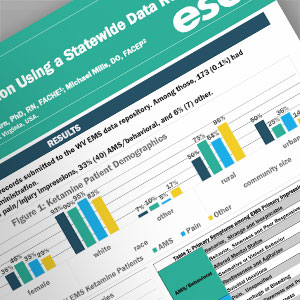ABSTRACTS
A Descriptive Assessment of Prehospital Ketamine Administration Using a Statewide Data RepositoryAuthor: Antonio Fernandez PhD, NRP | Research Scientist | ESO Associate Authors: Crowe, Remle, P, PhD, NREMT | Myers, J. Brent, MD, MPH, FACEP | Bourn, Scott, PhD, RN | Mills, Michael, R, D.O. FACEP
Introduction: Ketamine is a powerful analgesic with a favorable risk profile. Few studies have described patients who received prehospital ketamine. Objective: Describe patients who received prehospital ketamine in West Virginia (WV). Methods: This retrospective observational study included all WV 9-1-1 patients that received prehospital ketamine from 1/1/2019-12/31/2019. Data were obtained from the WV EMS data repository. WV protocols allow ketamine administration for pain and Excited Delirium. Therefore, EMS provider impressions were categorized as pain/injury, altered mental status (AMS)/behavioral, and other. Patient primary symptom, demographics, and community size were evaluated. Descriptive statistics were reported. Results: In 2019, there were 154,906 WV 9-1-1 patients and 173 (0.1%) received prehospital ketamine. Among all prehospital ketamine patients, most were male (63%, 106), white (93%, 135), and in urban areas (50%, 76). Median age was 41 (interquartile range [IQR]: 29-59). There were 62% (74) of patients with pain/injury impressions, 33% (40) AMS/behavioral, and 6% (7) other. Among patient with pain/injury impressions, 71% (48) had a primary symptom of unspecified pain, 21% hemorrhage/bleeding, 3% (2) slowness/poor responsiveness, 2% (1) abdominal tenderness, 2% (1) abnormal involuntary movements, 2% (1) dyspnea, and 2% (1) nausea. Most were male (65%, 46), white (95%, 60), and in rural areas (64%, 44). Median age was 45.5 (IQR: 29-60). Among patients with AMS/behavioral impressions, 46% (12) had a primary symptom of strange/inexplicable behavior, 31% (8) slowness/poor responsiveness, 8% (2) AMS, 8% (2) combative/violent behavior, 4% (1) restlessness/agitation, and 4% (1) suicidal ideations. Most were male (54%, 21), white (90%, 26), and in urban areas (75%, 24). Median age was 35 (IQR: 28-62). Among patients with other impressions, the only primary symptom reported was unspecified pain, 71% (5) were male, 83% (5) white, and 86% (6) in urban areas. Median age was 72 (IQR: 41-76). Conclusion: More WV 9-1-1 patients received prehospital ketamine for pain/injury than for AMS/behavioral impressions. Ketamine for pain/injury was administered more often in rural areas while ketamine for AMS/behavioral impressions was more frequent in urban areas. Those with pain/injury were older than those with AMS/behavioral impressions. Future research should evaluate the effectiveness of ketamine for pain/injury and AMS/behavioral impressions.
|

